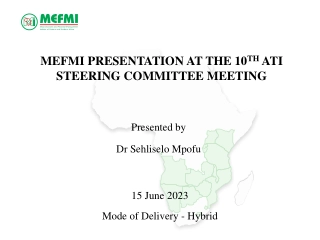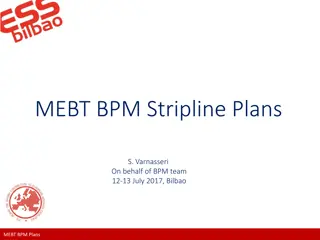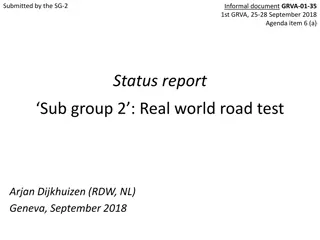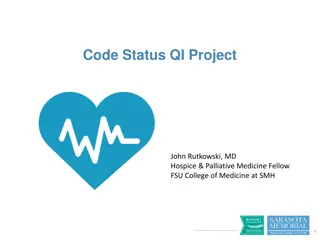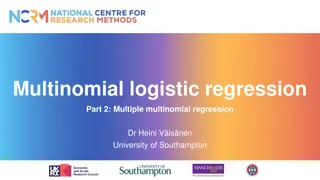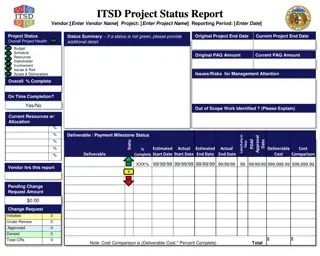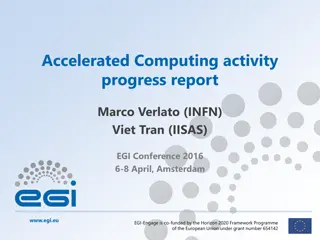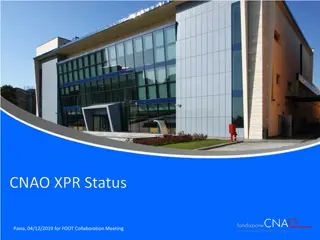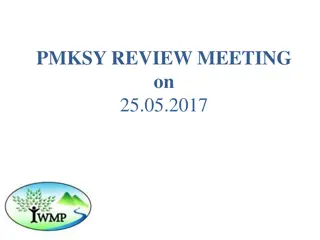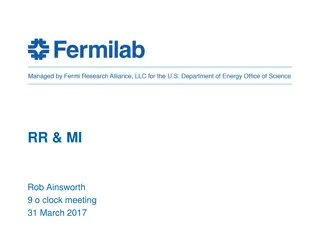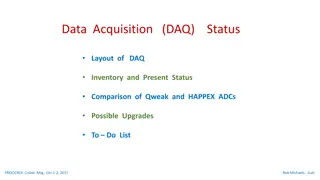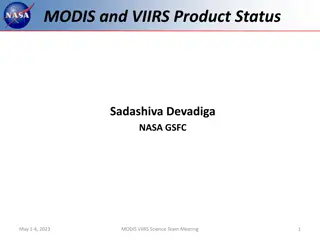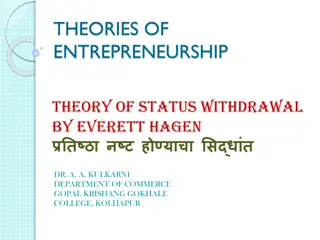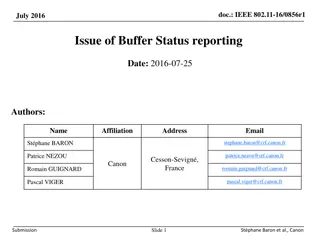Status of ENSAR2 JRA2 PSeGe Collaboration Meeting
ENSAR2 project facilitates research in Nuclear Structure, Reactions, and Applications with access to top facilities. JRA2 focuses on R&D of Position-Sensitive Germanium Detectors for Nuclear Structure and Applications. The status of tasks, participants, and progress in the collaboration meeting held from 4th to 6th April 2018 is detailed. It includes contributions to detector technology, imaging applications, and associated detector technologies. Key areas of R&D, such as novel Ge-detector geometries, segmented p-type coaxial detectors, passivation, and segmentation, are highlighted.
Download Presentation

Please find below an Image/Link to download the presentation.
The content on the website is provided AS IS for your information and personal use only. It may not be sold, licensed, or shared on other websites without obtaining consent from the author.If you encounter any issues during the download, it is possible that the publisher has removed the file from their server.
You are allowed to download the files provided on this website for personal or commercial use, subject to the condition that they are used lawfully. All files are the property of their respective owners.
The content on the website is provided AS IS for your information and personal use only. It may not be sold, licensed, or shared on other websites without obtaining consent from the author.
E N D
Presentation Transcript
Status of the ENSAR2 JRA2 - PSeGe A.Gadea (IFIC-Valencia) for the PSeGe Collaboration 2ndAGATA-GRETINA tracking arrays collaboration meeting 4th- 6thApril 2018
ENSAR2 (project number: 654002) is the integrating activity for European nuclear scientists who are performing research in three of these major subfields: Nuclear Structure, Nuclear Reactions and Applications of Nuclear Science. Its core aim is to provide access to eleven of the complementary world- class large-scale facilities: GANIL-SPIRAL2 (F), INFN (LNL & LNS) (I),CERN-ISOLDE (CH), JYFL (FI), ALTO (F), GSI (D), KVI-CART (NL), NLC (IFJ PAN-Krakow & HIL-Warsaw) (PL), IFIN-HH/ELI-NP (RO) and to the theoretical physics facility: ECT* (I). It provides as well Network and Joint Research Activities funding. ENSAR2 started on March 1st, 2016. It will last 4 years ENSAR2 is funded by the European Commission within its HORIZON2020 Programme under the specific programme 'Infrastructures'.
JRA2 PSeGe R&D on Position-Sensitive Germanium Detectors for Nuclear Structure and Applications. Andres.Gadea@ific.uv.es, Daniel.R.Napoli@lnl.infn.it, Peter.Reiter@ikp.uni-koeln.de http://psege.lnl.infn.it The present project is contributing to the R&D of detector technology for position-sensitive HPGe detector arrays. R&D on key areas as detector technology. The work of the JRA2 is proceedings according to plan. Participants: IFIC-CSIC: personnel funds for Task3 INFN-LNL: personnel funds for Task 1 Uni. Cologne: personnel funds for Task 1 GSI: personnel funds for Task 2 Uni. Liverpool: networking funds for Task 4 CNRS: networking funds for Task 4 Task 2: R&D on novel Ge-detector geometries for ultimate position resolution and efficiency Modeling and simulation of electrical-field distributions, evaluation of the 3D position resolution obtainable, production of a prototype detector in cooperation with the industrial partner, experimental determination of the performance figures with the produced prototype. Task 3: R&D on segmented p-type coaxial detectors R&D on basic properties of the dopants producing high hole-barrier n-contacts, evaluation of the barrier and study of segmentation with these materials. Associated partners: KTH &University of Uppsala, Sweden, ELI-NP, Romania, University of Milan, Italy, STFC, UK, University of Salamanca & University of Valencia, Spain, CEA-Saclay, France Task 4: Demonstration of imaging applications and associated detector technologies 4.1: Demonstration of imaging applications 4.2: Detector encapsulation techniques 4.3: R&D on associated Detector technologies 4.4: PSA and neutron-gamma discrimination Task 1: New technologies on passivation and segmentation R&D of segmented contacts in HPGe detectors and of the passivation of the boundary regions between contacts, charge collection and electric-field exploration via 2D scans.
Status (I) Task 1: New technologies on passivation and segmentation Contract assigned to INFN ongoing (Walter Rainiero) since 3/11/2016 Done the first test of implantation of Boron in planar detectors to produce new contact technologies Now working in the preparation of a coaxial detector from a raw Ge- HP crystal in order to check the new contact technology in quasi- coaxial detectors. The contract for a post doc position in IKP-Cologne is assigned (Herbert Hess) starting from 1.12.2016. Funds will be used until 31.8.2018 Work on the new encapsulation technique at IKP-Cologne. Cryostat development is ongoing for new detector prototypes in collaboration between IKP-Cologne and INFN.
Activities ongoing: V.Boldrini et al: Characterization of thermally induced shallow defects in HPGe.Thermally-induced defects and contamination in candidates for HPGe doping techniques. W.Raniero et al: Preparation of segmented coaxial detector prototypes with new pasivation techniques. F. Sgarbossa et al.: Investigation of P Monolayer Doping in Germanium New Hydride Passivation Techniques
Status (II) Task 2: R&D on novel Ge-detector geometries for ultimate position resolution and efficiency Contract on-going (Tugba Arici) Proceeding with the prototype of quasiplanar geometry for position sensitive Ge detectors. First prototype is now been characterized.
Status (II) Task 3: R&D on segmented p-type coaxial detectors Test on the use of Phosphorous for dopant diffusion and activation for the junction formation done, not good results. Now Sb as dopant being tested. Collaboration established with the Micro electronics group of the University of Padova, Italy Ongoing contract for a pre-doctoral collaborator Stefano Bertoldo. Diode Prototype 1cm2, 2mm thick Under test n contact Sb P contact B
Status (III) Task 4: Demonstration of imaging applications and associated detector technologies Done the 1stand the 2ndworkshops on Detector R&D, Applications and associated technologies.3rdbeing organized Training sessions on advanced detector technology organized. Collaboration on-going on Position Sensitive Ge Detector Imaging applications. IKP-Cologne is contributing to the developments with the work of a master student (Rouven Hirsch) working on gamma ray imaging with two different position sensitive HPGe detectors: a cylindrical coaxial detector, and tapered AGATA detector both 36 fold segmented. This work performed in collaboration with University of Liverpool.
Summary: The PSeGe activity is progressing timely in several fronts. Prototypes in Task 1, i.e. new pasivation techniques, Task 2, i.e. new geometries, and Task 3, i.e. p-type contacts, exist or are being produced. Promising p-type contacts based on Sb. Networking funds allow the organization of the workshops and training visits to the Laboratories with Ge detectors experts.


